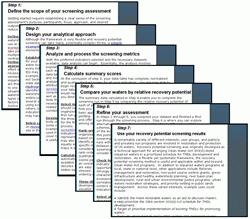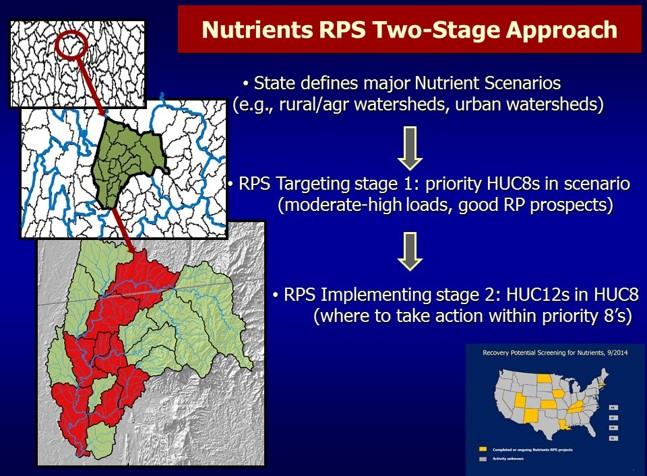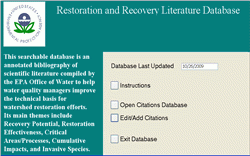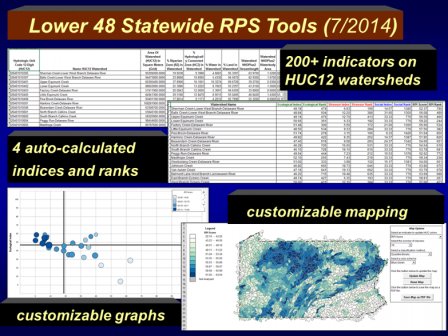Learn about Recovery Potential Screening (RPS)
 Restoring the nation's tens of thousands of impaired waters is an immense challenge. No single restoration program, public or private, has the resources to work on all impaired waters at once. Well-informed planning and good choices of places to take action with limited resources are essential to produce more and earlier successes, with greater benefits to society and the environment. The concept of recovery potential - the relative restorability of a water body - is an important consideration for restoration programs whose main goal is to bring about recovery.
Restoring the nation's tens of thousands of impaired waters is an immense challenge. No single restoration program, public or private, has the resources to work on all impaired waters at once. Well-informed planning and good choices of places to take action with limited resources are essential to produce more and earlier successes, with greater benefits to society and the environment. The concept of recovery potential - the relative restorability of a water body - is an important consideration for restoration programs whose main goal is to bring about recovery.
This website on Recovery Potential Screening (RPS) provides a systematic approach for comparing watersheds, their condition and how well they may respond to restoration or protection efforts. RPS compares watersheds rather than water bodies themselves because a wide variety of watershed characteristics strongly influence the condition of the waters they encompass. Originally, the RPS approach was developed to help states, territories and authorized tribes (hereafter referred to as states, for brevity) develop “a prioritized schedule" for creating Total Maximum Daily Loads (TMDLs) to reduce pollution in impaired waters. More than ten years of application has shown that RPS can also support a wide range of other types of watershed comparisons across the US, mainly because it can be customized to the user’s specific needs. Rather than a 'one-size-fits-all' procedure, this website offers a flexible framework of methods, technical information, instructional examples and tools that can be tailored to any watershed program or purpose in any geographic locality. When used with existing data, RPS provides a rapid watershed assessment and comparison method at a general screening level. RPS is useful to numerous Clean Water Act-related programs, but it is not an EPA requirement nor does it constitute or modify EPA policies or program guidance.
 What RPS Does. Recovery Potential Screening is a technical method for comparing large numbers (e.g., hundreds to thousands) of watersheds. This is a method that measures, for each watershed, several ecological, stressor and social indicators that are associated with the likelihood that a watershed is in reasonably good condition and a protection or restoration effort may succeed. The user selects the indicators based on what is most appropriate to the watersheds being assessed and their surrounding communities, the availability of quality data and the goals of the restoration effort. Measuring the same indicators on all watersheds allows for systematic, consistent and information-based comparison. Calculating separate ecological, stressor and social indices enables the user to consider each of these three classes of factors, individually or in combination. The ecological index score reflects overall current condition and resilience (i.e., the capacity of the watershed to maintain or regain functionality) based on metrics related to natural watershed processes and structure. The stressor index score reflects the pressures on watershed condition from several primary sources of pollutants and water quality impairments. The social index score can include many factors, such as community involvement, incentives, economics, governance, regulation and planning status, that do not constitute watershed condition or stressors but often strongly influence the level of effort and complexity of achieving improvements. A Recovery Potential Integrated (RPI) score is calculated by combining these three indices into a fourth, overall index. The three component index scores, however, are usually more informative individually and thus more useful than the RPI score alone.
What RPS Does. Recovery Potential Screening is a technical method for comparing large numbers (e.g., hundreds to thousands) of watersheds. This is a method that measures, for each watershed, several ecological, stressor and social indicators that are associated with the likelihood that a watershed is in reasonably good condition and a protection or restoration effort may succeed. The user selects the indicators based on what is most appropriate to the watersheds being assessed and their surrounding communities, the availability of quality data and the goals of the restoration effort. Measuring the same indicators on all watersheds allows for systematic, consistent and information-based comparison. Calculating separate ecological, stressor and social indices enables the user to consider each of these three classes of factors, individually or in combination. The ecological index score reflects overall current condition and resilience (i.e., the capacity of the watershed to maintain or regain functionality) based on metrics related to natural watershed processes and structure. The stressor index score reflects the pressures on watershed condition from several primary sources of pollutants and water quality impairments. The social index score can include many factors, such as community involvement, incentives, economics, governance, regulation and planning status, that do not constitute watershed condition or stressors but often strongly influence the level of effort and complexity of achieving improvements. A Recovery Potential Integrated (RPI) score is calculated by combining these three indices into a fourth, overall index. The three component index scores, however, are usually more informative individually and thus more useful than the RPI score alone.
In addition to auto-calculating these four indices, the versatile RPS Tool also makes it possible to compare watershed values for any single indicator for which data are available. Statewide RPS Tools already containing over 200 watershed indicators are available for the lower 48 states from this website.
 There are many uses for Recovery Potential Screening because there are so many different reasons for wanting to compare watersheds and inform decision-making. Some users apply screening results to identify the better prospects for successful restoration and target these watersheds as a priority. Others use the screening method to increase awareness of the relative difficulty of restoration in their watersheds, then apply these insights to planning and implementing a best course of action. Some may use the Tool simply out of curiosity to view differences among watersheds based on just one factor. Still others have used the RPS Tool to identify healthy watersheds for protection. Recovery Potential Screening does not designate any watershed as definitely unrestorable or restorable; it is a comparative, decision support tool that estimates relative differences in condition and restorability among watersheds, based on multiple lines of evidence.
There are many uses for Recovery Potential Screening because there are so many different reasons for wanting to compare watersheds and inform decision-making. Some users apply screening results to identify the better prospects for successful restoration and target these watersheds as a priority. Others use the screening method to increase awareness of the relative difficulty of restoration in their watersheds, then apply these insights to planning and implementing a best course of action. Some may use the Tool simply out of curiosity to view differences among watersheds based on just one factor. Still others have used the RPS Tool to identify healthy watersheds for protection. Recovery Potential Screening does not designate any watershed as definitely unrestorable or restorable; it is a comparative, decision support tool that estimates relative differences in condition and restorability among watersheds, based on multiple lines of evidence.
 Using this Website. There are numerous ways to use this website. Primarily, the site provides an instructional pathway and related materials for technical users who wish to carry out a Recovery Potential Screening assessment. However, the site also contains many types of less technical watershed information. The multi-step RPS methodology is described at a clear and basic level, but also supported by a more complex and technical variety of onsite tools and technical resources.
Using this Website. There are numerous ways to use this website. Primarily, the site provides an instructional pathway and related materials for technical users who wish to carry out a Recovery Potential Screening assessment. However, the site also contains many types of less technical watershed information. The multi-step RPS methodology is described at a clear and basic level, but also supported by a more complex and technical variety of onsite tools and technical resources.
Central to applying the Recovery Potential Screening methodology is the RPS Tool, a specially coded Excel file that contains embedded watershed data and can calculate watershed indices, rank-ordered tables of watersheds, graphs and simple maps, all of which can be customized and saved as images for later use. Numerous other website features provide user support for the RPS methodology and tools. Users may wish to download the restoration and recovery literature database, which houses over 1600 citations of technical papers that describe recovery-relevant characteristics of waters or watersheds. These papers provided the basis for developing recovery potential indicators, which are accessible through this site in indicator summary form or in greater detail as indicator reference sheets that contain notes on measurement, data sources and excerpts from the technical literature.
 Scoring guidance helps users decide among the different options for assigning values and weights to each indicator, normalizing the values and refining RPS Tool screening results. Techniques for displaying results as rank-ordered data tables, 3-D bubble plot graphs or customizable maps are included to provide users different options for visualizing screening results and communicating about them to others. The website also includes brief summaries of example projects, reports and publications for further information.
Scoring guidance helps users decide among the different options for assigning values and weights to each indicator, normalizing the values and refining RPS Tool screening results. Techniques for displaying results as rank-ordered data tables, 3-D bubble plot graphs or customizable maps are included to provide users different options for visualizing screening results and communicating about them to others. The website also includes brief summaries of example projects, reports and publications for further information.
